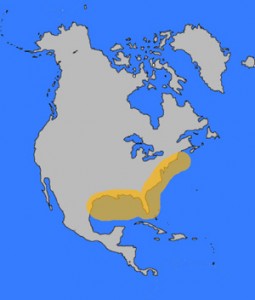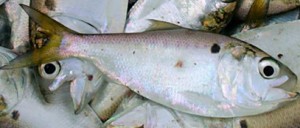Have you ever seen a flock of sparrows flying in unison. They all seem to move so well together you would swear it almost looks like a singular organism. Menhaden swim in much the same manner, all bundled up close to one another and moving in harmony with each other. They find strength in numbers and can confuse predators with their elaborate swimming maneuvers. It is quite the spectacle to see if you have ever seen them swimming in clear water.
Menhaden are a Keystone species that are incredibly important to the survival of the larger game-fish. Bluefish, Striped Bass, Mackerel, Tuna and Sharks depend upon the survival of Menhaden. Please keep this in mind while fishing for Menhaden and only take what is needed for your fishing trip or your own consumption.
Menhaden Fishing Facts
Menhaden are referenced by many names, Bunker, Pogies or Silver Sides are a few. Fishing Beginners often get confused when talking with the locals as generally anglers call them by a variety of different names. As mentioned above their role in the food chain in incredibly important. Bluefish, Striped Bass, Tuna and Shark feed on Menhaden regularly and are almost always found when Menhaden are present in the water.
Many anglers get upset with the large fishing boats called “draggers” that scoop up large volumes at a time. When they extract fish in these numbers often times the recreational fishing suffers as when the Menhaden are not present neither are the larger predators.
Menhaden Generally do not grow much larger than 16 inches long and have very vibrant silver sides. Their most noticeable characteristic is the dark black spot located behind their gill slit. Its function is unknown, but some speculate it is used to confuse predators.
They are filter feeders and their food source is small microscopic plants found in warmer waters above 50 degrees fahrenheit. Reproduction happens in open sea water and they do not need to migrate into freshwater to spawn.
One of the largest and eye opening events caused by chemical pollution is what is referred to as a “bloom” or “fish kill”. It occurs when their is not adequate oxygen in the water and the Menhaden and other fish suffocate by the thousands and wash ashore. Some believe that the Nitrogen used to fertilize lawns washes into warm water and depletes the oxygen levels. It is one of the most devastating things to witness if you are a nature lover like myself.
In recent years their has been a demand for Omega 3 Fatty Acids as the health benefits are numerous. Menhaden produce these fatty acids naturally and they are a good source of this type of oil. Supposedly Menhaden are a very delicious fish, but I have never tried one myself.
Menhaden are also a great baitfish to use for Bluefish, Striped Bass, Shark and Tuna.
How to Catch Menhaden
The easiest way to catch Menhaden is to “Snag” for them. This requires the use of a weighted treble hook called a “snagging” hook. “Snagging” can be achieved by making a cast into or behind a school of Menhaden and then reeling in the slack of the line. Once you
Many anglers will spend thier morning “Snagging” Menhaden to use for bait later on in the day. “Live Linning” a menhaden is a highly effective method to catch Bass and Bluefish.

Where to Catch Menhaden
Menhaden can be caught in ocean waters from the Gulf of Mexico to Nova Scotia. They are migratory fish so they are only in certain areas at certain times of the season. They can be snagged from a few feet from shore when they are abundant.
When is the Best Time to Catch Menhaden
From New York to Nova Scotia they can be found in 55 degree and warmer waters generally from July to September. From Florid to New York they are most active in May through July.



